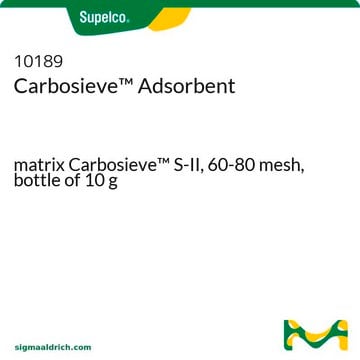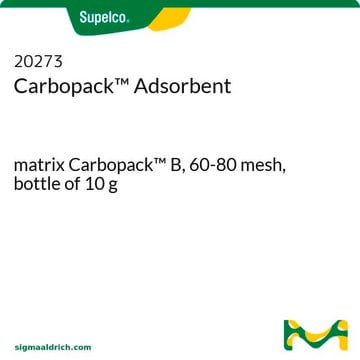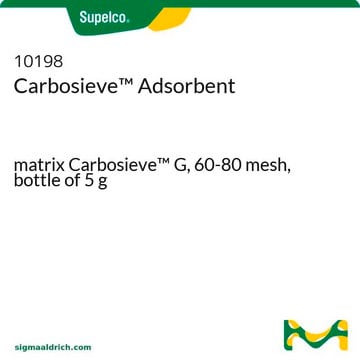10190-U
Carbosieve Carbon Adsorbent
matrix Carbosieve S-II, 80-100 mesh, bottle of 10 g
Synonim(y):
polymeric adsorbent, DVB, 80-100 mesh
About This Item
Polecane produkty
product name
Carbosieve Adsorbent, matrix Carbosieve S-II, 80-100 mesh, bottle of 10 g
linia produktu
Carbosieve
Postać
powder or granules
opakowanie
bottle of 10 g
metody
LPLC: suitable
gas chromatography (GC): suitable
solid phase extraction (SPE): suitable
powierzchnia
~1059 m2/g
macierz
Carbosieve S-II
grupa aktywna macierzy
carbon
wielkość cząstki
80-100 mesh
wielkość porów
~0.01 cm3/g mesoporosity
~0.45 cm3/g microporosity
~0 cm3/g macroporosity
~6-15 Å pore diameter
gęstość
~0.61 g/mL (free fall density)
metoda separacji
reversed phase
Szukasz podobnych produktów? Odwiedź Przewodnik dotyczący porównywania produktów
Powiązane kategorie
Opis ogólny
- Spherical (better packed bed performance than granular particles)
- Hard and non-friable (pack well, will not break)
- Highly porous (high surface areas)
- Used for molecules with an analyte size relative to C2-C5 n-alkanes
- Hydrophobic (can be used in high humidity environments)
Generally, CMS adsorbents offer greater relative adsorptive strength compared to spherical graphitized polymer carbon (SGPC) and graphitized carbon black (GCB) adsorbents. Our Carbosieve products are a type of CMS adsorbent.
- Have non-tapered pores
- Very strong adsorptive strength due to only containing micropores
- Provide great performance for many small, volatile analytes that most adsorbents have trouble retaining
For more information about any of our specialty carbon adsorbents, please visit sigma-aldrich.com/carbon
Informacje prawne
Kod klasy składowania
11 - Combustible Solids
Klasa zagrożenia wodnego (WGK)
nwg
Temperatura zapłonu (°F)
Not applicable
Temperatura zapłonu (°C)
Not applicable
Środki ochrony indywidualnej
Eyeshields, Gloves, type N95 (US)
Choose from one of the most recent versions:
Certyfikaty analizy (CoA)
Sorry, we don't have COAs for this product available online at this time.
If you need assistance, please contact Obsługa Klienta
Masz już ten produkt?
Dokumenty związane z niedawno zakupionymi produktami zostały zamieszczone w Bibliotece dokumentów.
Produkty
Synthetic CMS carbons offer tailored adsorbents for specific applications.
Syntetyczne węgle CMS oferują adsorbenty dostosowane do konkretnych zastosowań.
Nasz zespół naukowców ma doświadczenie we wszystkich obszarach badań, w tym w naukach przyrodniczych, materiałoznawstwie, syntezie chemicznej, chromatografii, analityce i wielu innych dziedzinach.
Skontaktuj się z zespołem ds. pomocy technicznej






